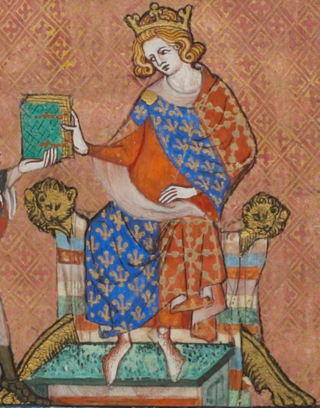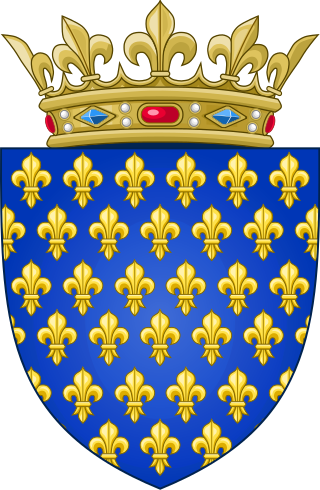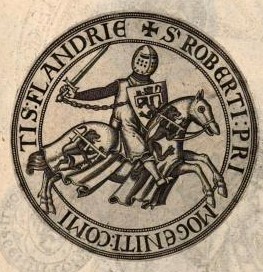Related Research Articles

Louis X, known as the Quarrelsome, was King of France from 1314 and King of Navarre from 1305 until his death. He emancipated serfs who could buy their freedom and readmitted Jews into the kingdom. His short reign in France was marked by tensions with the nobility, due to fiscal and centralisation reforms initiated during the reign of his father by Grand Chamberlain Enguerrand de Marigny.

Margaret, often called Margaret of Constantinople, ruled as Countess of Flanders during 1244–1278 and Countess of Hainaut during 1244–1253 and 1257–1280. She was the younger daughter of Baldwin IX, Count of Flanders and Hainaut, and Marie of Champagne.

Joan I was ruling Queen of Navarre and Countess of Champagne from 1274 until 1305. She was also Queen of France by marriage to King Philip IV. She founded the College of Navarre in Paris in 1305.

Philip of Rouvres was the Count of Burgundy and Count of Artois from 1347, Duke of Burgundy from 1349, and Count of Auvergne and Boulogne from 1360. He was the only son of Philip, heir to the Duchy of Burgundy, and Joan I, heiress of Auvergne and Boulogne.

Margaret III was a ruling Countess of Flanders, Countess of Artois, and Countess of Auvergne and Boulogne between 1384 and 1405. She was the last Countess of Flanders of the House of Dampierre.
Margaret Wake, suo jure3rd Baroness Wake of Liddell and Countess of Kent, was the wife of Edmund of Woodstock, 1st Earl of Kent, the youngest surviving son of Edward I of England and Margaret of France.

Louis I was Count of Flanders, Nevers and Rethel.

Joan of Flanders was duchess of Brittany by her marriage to John of Montfort. Much of her life was taken up in defense of the rights of her husband and, later, son to the duchy, which was challenged by the House of Blois during the War of the Breton Succession. Known for her fiery personality, Joan led Montfort's cause after her husband had been captured by Philip VI of France, and began the fight back. There, she displayed considerable skill as a military leader and gained the respect of her people.

The Flemish peasant revolt of 1323–1328, sometimes referred to as the Flemish Coast uprising in historical writing, was a popular revolt in late medieval Europe. Beginning as a series of scattered rural riots in late 1323, peasant insurrection escalated into a full-scale rebellion that dominated public affairs in Flanders for nearly five years until 1328. The uprising in Flanders was caused by excessive taxations levied by the Count of Flanders Louis I and by his pro-French policies. The insurrection had urban leaders and rural factions, which took over most of Flanders by 1325.

The House of Capet ruled the Kingdom of France from 987 to 1328. It was the most senior line of the Capetian dynasty – itself a derivative dynasty from the Robertians and the Karlings.
The first rulers of Rethel might have governed under the Abbey of Saint-Remi and later independently, before the county passed first to the counts of Nevers, then to the counts of Flanders, and finally to the dukes of Burgundy. In 1405 the county became part of the peerage of France, and in 1581 it was elevated to a duchy. In 1663 it became the Duchy of Mazarin.

Robert III, also called Robert of Béthune and nicknamed The Lion of Flanders, was the Count of Nevers from 1273 and Count of Flanders from 1305 until his death.

Joan of Valois was a Countess consort of Hainaut, Holland, and Zeeland, by marriage to William I, Count of Hainaut. She acted as regent of Hainaut and Holland several times during the absence of her spouse, and she also acted as a political mediator.

Joan II, Countess of Burgundy, was Queen of France by marriage to Philip V of France; she was also ruling Countess of Burgundy from 1303 to 1330 and ruling Countess of Artois in 1329–1330.

Yolande II or Yolande of Nevers, was ruling Countess of Nevers between 1262 and 1280.
Joanna of Hainault was a Duchess of Jülich by marriage to William V, Duke of Jülich. She was the third daughter of William I, "The Good" Count of Hainaut, and Joan of Valois. She was a younger sister of Philippa of Hainault, Queen of England, and Margaret II, Countess of Hainault.

Louis I was suo jure Count of Nevers and jure uxoris Count of Rethel.

The House of Dampierre played an important role during the Middle Ages. Named after Dampierre, in the Champagne region, where members first became prominent, members of the family were later Count of Flanders, Count of Nevers, Count of Rethel, Count of Artois and Count of Franche-Comté.
Maud Holland, LG, also known by her titles through marriage as Lady Courtenay and Countess of St Pol, was an English noblewoman. She was a daughter of Thomas Holland, 1st Earl of Kent and Joan of Kent. After Thomas' death Joan married Edward the Black Prince, who was then Prince of Wales. One of Joan and Edward's sons was the future King of England, Richard II. When she was aged around eight Edward arranged a marriage for Maud to Hugh Courtenay, whom she married, with royal and papal approval. Her husband, with whom she had no children, died in 1374. Maud was one of the first women to be invested as ladies of the Order of the Garter, when Richard II appointed many of his relatives to the order in 1378. In 1380 Maud married Waleran III, Count of Ligny, a French nobleman. After her death she was apparently buried in Westminster Abbey but the location of her grave is not known.
References
- ↑ Sarpy, Julie (2019-05-15). Joanna of Flanders: Heroine and Exile. Amberley Publishing Limited. ISBN 978-1-4456-8855-8.
- ↑ Lucas 1946, p. 80.
- ↑ Sarpy 2015, p. 7.
- ↑ Nicholas 1992, p. 442.